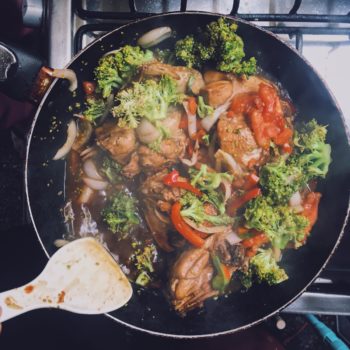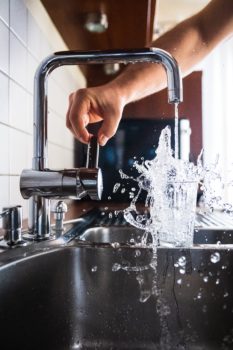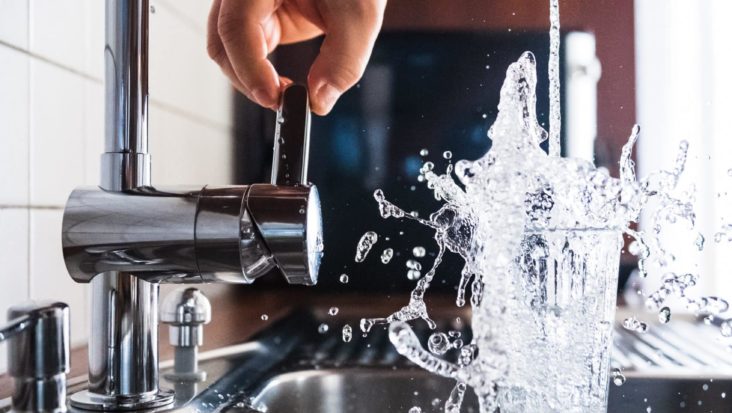posted July 27, 2021
by Laura Leal, VLCE

A long time ago, I started collecting water bottles from all over the world. The bottles just seemed attractive to me, but I didn’t know much about water. I had a table where I put all my bottles and I thought it looked nice. But then I learned about water sommeliers (I couldn’t believe that they existed!) and I discovered that many of my nice bottles of water were the brands water sommeliers tasted.
It turns out that water is much more than H2O and a nice bottle. The amount, composition, and quality of water that we use in our daily cooking determines the texture, flavor, physical appearance of our foods and long-term healthfulness of foods.
Most filtered waters are labeled as “pure water,” which means it is plain H2O. But all waters, whether from a well, city supply, or bottled, contain small quantities of minerals, organic substances, and air. With bottled waters, the label lists the amount of Total Dissolved Solids (TDS), quantifying inorganic salts and small amounts of organic matter present in solution in the water. Principal components of TDS in water are usually calcium, magnesium, sodium, and potassium cations and carbonate, hydrogen carbonate (bicarbonate), chloride, sulfate, and nitrate anions.[1]

All life, including our own, exists in a water solution. Water is found in fresh foods of all kinds and it is a major ingredient in most cooked dishes. Water is what makes foods seem moist, and its loss is what makes them seem pleasantly crisp or unpleasantly dry. It is also an important cooking medium; we cook many foods in hot water or in the watery fluids from other foods. Its acidity or alkalinity affects the reactions of other food molecules and are important factors in cooking. Acid liquids, like fruit juices and vinegars, taste sour, while alkaline liquids, such as egg whites and tap water, taste flat. The boiling point is also an important cooking landmark, 212°F/100°C at sea level, that is hot enough to kill bacteria and microbes, soften vegetables, and firm meats and fish.
There are several recommended actions to take in order to guarantee food quality and safety when using tap water for cooking. If your dwelling is old, newly plumbed, or part of a multi-unit building, testing tap water for lead is important. Today “lead-free” fixtures may legally contain some lead. Lead accumulates in the body and is often found in drinking water run through plumbing. If you haven’t drawn any water for hours from your fixture, make sure to let it run for 1 to 2 minutes, this way it can release undesirable amounts of lead, copper, and zinc that accumulated in the water while sitting in the pipes. If the water is going to be in direct contact with food, always use cold water from the tap as hot water carries more dissolved metals. Use hot water from the tap for steaming or in water baths where the water is not going to be in direct contact with food.
Too much calcium and magnesium can cause a bitter taste. In addition, pale foods may turn yellow, scum may form on brewed tea, boiled vegetables and grains may take too long to cook. If you experience any of these problems, try using bottled water for brewing tea and steaming vegetables instead of boiling them.

Lastly, check the taste and pH of your tap water. Run the cold water for a minute, fill a glass, let it warm to room temperature, and taste it. If the taste is unpleasant, try to improve it with a water filter. The ideal pH for most cooking is a neutral 7. You can get pH papers from a scientific supply company to test this. To adjust the pH, you can add a little baking soda to make acidic water more alkaline, or a little lemon juice, citric acid, or cream of tartar to make alkaline water more acidic.
We take the behavior of water for granted because water is present everywhere. But studies show making the same recipe with different waters often results in differences in color, taste, and texture. Paying attention to your water when cooking is likely to improve your dishes.
[1] https://www.who.int/water_sanitation_health/dwq/chemicals/tds.pdf

Laura Leal is a Main Street Vegan Academy graduate from Monterrey, Mexico. She has been a Chef instructor since 2006 and owns BōnMot Ice Cream and a restaurant, Common Bowlery. In the food business since 2001, Laura’s passion for food and teaching has always been fused. Her mission is to offer more plant-based options in the city throughout all of her businesses. You can follow her on Instagram @lauraleal_instituto and Facebook @Cheflauralealp.

